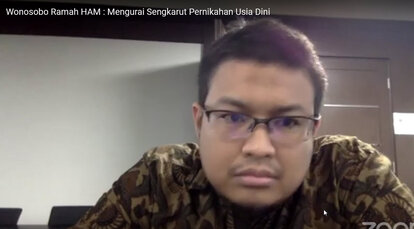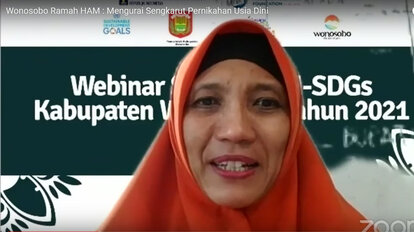Human Rights
Ineradicable Child Marriage in Wonosobo: Who's Responsible?

FNF Indonesia collaborated with the Wonosobo Regency Government and held an online discussion with the topic ”Mengurai Sengkarut Perkawinan Usia Anak di Kabupaten Wonosobo” (Unravel the Complexity of Child Marriage in Wonosobo Regency) on Thursday (17/6/2021).
Wonosobo scored an outstanding number of child marriage practices. In 2018, records shows there's 2109 cases of child marriage, which fortunately declining in the years after that -- 2018 cases in 2019, and 968 cases in 2020.
Fahmi Hidayat, Desk Coordinator of Wonosobo Human Rights Friendly Regent, started the discussion with his opening remarks.
"It is hoped that this discussion could give literacy and a better understanding to all parties in order to control the execution of child marriage practices to take place," stated Fahmi.

FNF Project Director, Dr. Almut Besold, delivered her perspective on child marriage practices.
"Child marriage does indeed gives an instant solution to a right-now problem but only for a short term, in the long term it will create a much more series of serious problems," stated Dr. Besold.
Who is Responsible for Holding the Rein of Child Marriage?
To answer this question, let's take a look at the explanations from the following resource persons:
Yusuf Romli, staff at the International Cooperation Division from the Ministry of Law and Human Rights, explained the role of the Ministry of Law and Human Rights in child marriage.

"The Ministry of Law and Human Rights had established a 'Law-Conscious' Village, that is a foster village where one of the criteria is there must not be any child marriage practices take place," stated Yusuf.
Therefore, we can understand that the synergy between the government and all parties in controlling child marriage is essential.
This statement is agreed upon by Erna Yuniwati, Head of the PP PA Division of the Population Control Office of KB PP and PA Wonosobo Regency.
She explained that the common reason why pleader seeks permission to conduct child marriage is because of promiscuity and school drop-outs.
"Wonosobo District has established an Integrated Service Center (PPT) to control child marriage, specifically PUSPAGA (Family Learning Center) which task is providing recommendations or services (regarding family issues)," explained Erna.

The marriage control strategy for KB PP PA Wonosobo, continued Erna, focuses on two main things: improvising the family's quality and fulfilling the children's rights.
"Improving the quality of families could create a happy and eternal family that is in accordance to Pancasila number one. Moreover, child fulfillment program emphasizes the obligation of parents to prevent child marriage," explained Erna.
Also present is Muhsin, The Judge of the Religious Court Wonosobo (Eselon III/a) who shares about the ongoing judicial process and what the religious court can do to control child marriage.
"Although it's not allowed (legally), there can be an exception where the parents of the male and female (who wishes to be married) ask for dispensations to the court on the grounds of the matter being very urgent and provided supporting evidence to carry out child marriage," said Muhsin.
He added that the dispensation is given due to sudden reasons, based on article 7 section 2 of Law 15/2019, because of the child's own will and cases of pregnancy out of wedlock.

Marriage as an Escape from Poverty
Other findings shows that economy plays a big role in normalizing the practice of child marriages. Getting married is seen as combining the two families economy or financial expenses together, therefore for some families who are struggling financially, marriage is seen as an attempt to lessen the burden of their financial struggles.
With that reasoning, Rumiyati from KITA Institute Wonosobo initiated the movement to overcome child marriage.
"The KITA institute has established a mission to carry out an empowerment movement through activities such as Peer Counseling Training and Literacy via "KITA Reading House," said Rumiyati.
Rumiyati hopes that the effort made by the KITA institute will become a vehicle that empowers children who originally wanted to become brides, turned into an actor who voices the dangers of child marriage.
In addition to discussing counter efforts carried out by various sectors, this discussion also discusses the risks of child marriage.
Meanwhile, Zumrotin, from Indonesia Women's Health Foundation, an activist who fights for the revision of the child marriage law, said that the revision of the marriage law was not enough.
"Revising the Child Marriage law alone is not enough to control the rate of child marriage. The emphasis on the dangers of child marriage on the health of mothers and babies also needs to be socialized," said Zumrotin
Conclusion
Unraveling the chaos of child marriage is a long journey, but it is not impossible to be done. In the first-level environment, there are parents, children, mass organizations, and religious leaders. In the second-level environment there is the community that can embrace others (activists, PKK, and NGOs) to educate, stop or provide other opportunities for parents and children so that they are not tempted to marry at an early age.
Then, on the third-level environment, there are the Religious Court and the KBB PA service, and local governments whose role is to be responsible and be ready to prepare recommendations for dispensation
Now, we have to see our closest position; are we on the first, second, or third level of environment? All of us have a shared responsibility to prevent child marriage and restore the purpose of marriage to form a good family.
*Written by Elgawaty, translated from Bahasa Indonesia by Arum Sekarsari (FNF Jakarta Intern).
